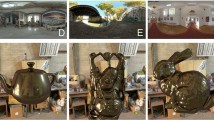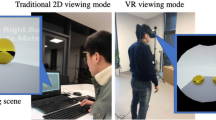Abstract
Many representations and rendering techniques have been proposed for presenting material appearance in computer graphics. One outstanding problem is evaluating their accuracy. In this paper, we propose assessing accuracy by comparing human judgements of material attributes made when viewing a computer graphics rendering to those made when viewing a physical sample of the same material. We demonstrate this approach using 16 diverse physical material samples distributed to researchers at the MAM 2014 workshop. We performed two psychophysical experiments. In the first experiment, we examined how consistently subjects rate a set of twelve visual, tactile and subjective attributes of individual physical material specimens. In the second experiment, we asked subjects to assess the same attributes for identical materials rendered as BTFs under point-light and environment illuminations. By analyzing obtained data, we identified which material attributes and material types are judged consistently and to what extent the computer graphics representation conveyed the experience of viewing physical material appearance.














Similar content being viewed by others
References
Adelson, E.H.: On seeing stuff: the perception of materials by humans and machines. In: Human vision and electronic imaging VI, vol. 4299. International Society for Optics and Photonics (2001)
Brodatz, P.: A Photographic Album for Artists and Designers (Brodatz Texture Database). Dover Publications, Mineola (1966)
Dana, K., van Ginneken, B., Nayar, S., Koenderink, J.: Reflectance and texture of real-world surfaces. ACM Trans. Graph. 18(1), 1–34 (1999)
Filip, J.: Analyzing and predicting anisotropic effects of BRDFs. In: ACM SAP, pp. 25–32 (2015)
Filip, J., Chantler, M., Green, P., Haindl, M.: A psychophysically validated metric for bidirectional texture data reduction. ACM Trans. Graph. 27(5), 138 (2008)
Filip, J., Vacha, P., Haindl, M.: Analysis of human gaze interactions with texture and shape. In: S+SSSPR Workshop, Springer LNCS 7252, pp. 160–172 (2011)
Filip, J., Vávra, R., Haindl, M., Zid, P., Krupicka, M., Havran, V.: BRDF slices: accurate adaptive anisotropic appearance acquisition. In: Proceedings of the 26th IEEE Conference on Computer Vision and Pattern Recognition, CVPR 2013, pp. 4321–4326 (2013)
Fleming, R.W.: Visual perception of materials and their properties. Vis. Res. 94, 62–75 (2014)
Goodman, T.: Measurement of naturalness: physics and perception. In: Proceedings of the 3rd International Conference on Appearance, pp. 21–24. MIT Press, Cambridge
Havran, V., Filip, J., Myszkowski, K.: Perceptually motivated BRDF comparison using single image. Comput. Graph. Forum (2016). https://doi.org/10.1111/cgf.12944
Hayes, A.F., Krippendorff, K.: Answering the call for a standard reliability measure for coding data. Commun. Methods Meas. 1(1), 77–89 (2007)
ITU: ITU-R.REC.P.910. Subjective audivisual quality assessment methods for multimedia applications. Technical report (2008)
Jarabo, A., Wu, H., Dorsey, J., Rushmeier, H., Gutierrez, D.: Effects of approximate filtering on the appearance of bidirectional texture functions. IEEE Trans. Vis. Comput. Graph. 20(6), 880–892 (2014). https://doi.org/10.1109/TVCG.2014.2312016
Keelan, B.: ISO 20462: a psychophysical image quality measurement standard. In: Proceedings of the SPIE, SPIE 2003, vol. 5294, p. 181–189 (2003)
Long, H., Leow, W.: A hybrid model for invariant and perceptual texture mapping. In: Proceedings of the 16th International Conference on Pattern Recognition, 2002, vol. 1, pp. 135–138. IEEE (2002)
Martín, R., Iseringhausen, J., Weinmann, M., Hullin, M.B.: Multimodal perception of material properties. In: Proceedings of the ACM SIGGRAPH Symposium on Applied Perception, SAP ’15, pp. 33–40 (2015). https://doi.org/10.1145/2804408.2804420
Matusik, W., Pfister, H., Brand, M., McMillan, L.: A data-driven reflectance model. ACM Trans. Graph. 22(3), 759–769 (2003)
Meseth, J., Müller, G., Klein, R., Röder, F., Arnold, M.: Verification of rendering quality from measured BTFs. In: Third Symposium on Applied Perception in Graphics and Visualization, pp. 127–134 (2006)
Mojsilovic, A., Kovacevic, J., Kall, D., Safranek, R., Kicha Ganapathy, S.: The vocabulary and grammar of color patterns. IEEE Trans. Image Process. 9(3), 417–431 (2000)
Motoyoshi, I., Nishida, S., Sharan, L., Adelson, E.: Image statistics and the perception of surface qualities. Nature 447(10), 206–209 (2007)
Mylo, M., Giesel, M., Zaidi, Q., Hullin, M., Klein, R.: Appearance bending: a perceptual editing paradigm for data-driven material models. In: Hullin, M., Klein, R., Schultz, T., Yao, A. (eds.) Vision, Modeling and Visualization. The Eurographics Association (2017). https://doi.org/10.2312/vmv.20171254
Nicodemus, F., Richmond, J., Hsia, J., Ginsburg, I., Limperis, T.: Geometrical considerations and nomenclature for reflectance. NBS Monogr. 160, 1–52 (1977)
Ramanarayanan, G., Ferwerda, J., Walter, B., Bala, K.: Visual equivalence: towards a new standard for image fidelity. ACM Trans. Graph. 26(3), 76:1–76:10 (2007)
Ravishankar Rao, A., Lohse, G.: Towards a texture naming system: identifying relevant dimensions of texture. Vis. Res. 36(11), 1649–1669 (1996)
Rushmeier, H.: The MAM2014 sample set. In: Proceedings of the Eurographics 2014 Workshop on Material Appearance Modeling: Issues and Acquisition, MAM ’14, pp. 25–26 (2014). http://dx.doi.org/10.2312/mam.20141297
Sattler, M., Sarlette, R., Klein, R.: Efficient and realistic visualization of cloth. In: Eurographics Symposium on Rendering, pp. 167–178 (2003)
Serrano, A., Gutierrez, D., Myszkowski, K., Seidel, H.P., Masia, B.: An intuitive control space for material appearance. ACM Trans. Graph. 35(6), 186:1–186:12 (2016). https://doi.org/10.1145/2980179.2980242
Somol, P., Haindl, M.: Novel path search algorithm for image stitching and advanced texture tiling. In: WSCG 2005, pp. 155–218 (2005)
Tamura, H., Mori, S., Yamawaki, T.: Textural features corresponding to visual perception. IEEE Trans. Syst. Man Cybern. 8(6), 460–473 (1978)
Vangorp, P., Laurijssen, J., Dutre, P.: The influence of shape on the perception of material reflectance. ACM Trans. Graph. 26(3), 77:1–77:10 (2007)
Funding
This research has been supported by the Czech Science Foundation Grant 17-18407S and the US National Science Foundation Grant IIS-1218515.
Author information
Authors and Affiliations
Corresponding author
Ethics declarations
Conflict of interest
The authors declare that they have no conflict of interest.
Appendix: BIG data format description
Appendix: BIG data format description
The format stores image data by providing a list of image files to be included (so far PNG and EXR (half/float) image files are supported) together with optional meta data such as list of corresponding incoming and outgoing directions, color-space, spatial resolution, measured material name and descriptions. The stored binary data can be either loaded to the RAM or alternatively, for large datasets one can open a datafile and seek the requested data from a hard drive. The latter option is considerably slower but still acceptable for many off-line rendering scenarios. Once the file is loaded/opened one can use a standard “get-pixel” query function returning RGB triplet for specific spatial UV coordinate and image index. A transformation between image index and incoming/outgoing angles is up to the user and depends on an initial ordering of files during the saving process. Also we do not attempt to provide any compression of data as this could potentially impact visual quality and rendering speed. The compression can be easily added by extension of the format.
Since the proposed format is universal (it can include any LDR/HDR data), it allows an unified representation of any image-based information, e.g., movies, dynamic textures. The format also enables management of numerous scattered files that are difficult to handle without any metadata. The source codes for saving/loading of data to/from the format are made publicly available (http://btf.utia.cas.cz) to promote its wide usage and allowing easy adoption by various users for visualization and data analysis software packages. The format is composed of data chunks consisting of chunk ID, its size and data, as shown in a list of current data chunks and their brief description in Fig. 15.
Rights and permissions
About this article
Cite this article
Filip, J., Kolafová, M., Havlíček, M. et al. Evaluating physical and rendered material appearance. Vis Comput 34, 805–816 (2018). https://doi.org/10.1007/s00371-018-1545-3
Published:
Issue Date:
DOI: https://doi.org/10.1007/s00371-018-1545-3





